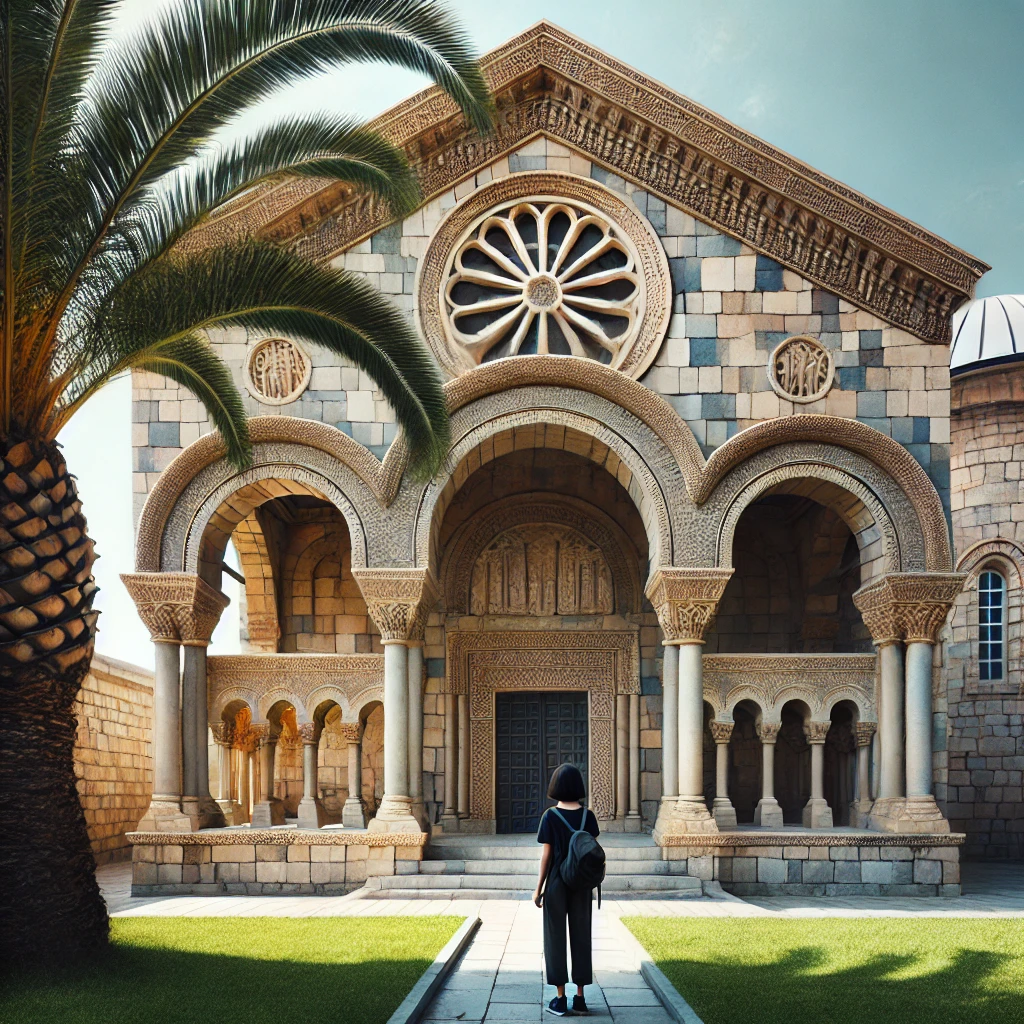ChatGPT:
Trabzon is a city located on the northeastern coast of Turkey, along the Black Sea. Its strategic location between Europe and Asia has made it a historically significant hub for trade, culture, and politics.
Origins and Early History
Trabzon, originally known as “Trapezus,” was founded around 756 BC by Greek colonists from Sinope, though some sources suggest it may have been settled even earlier by indigenous peoples. Its name comes from the Greek word “trapeza,” meaning “table,” referring to the flat-topped hill upon which the city was built.
As part of the ancient Greek world, Trabzon became a key trading post along the Black Sea, facilitating commerce between Greece, Persia, and the Caucasus. It was later absorbed into the Roman Empire in the 1st century BC and eventually became part of the Byzantine Empire.
Byzantine and Empire of Trebizond
During the Byzantine period, Trabzon grew in prominence as a fortified city, benefiting from its position on the Silk Road. In 1204, following the Fourth Crusade, the city became the capital of the Empire of Trebizond, a Byzantine Greek successor state. This empire lasted until 1461, when it was conquered by the Ottoman Sultan Mehmed II.
Ottoman Period
Under Ottoman rule, Trabzon remained an important center of trade and administration. The city developed as a multi-ethnic hub, home to Greeks, Armenians, Laz, and Turks. The Ottomans strengthened its role as a key port for trade between Anatolia, Persia, and the broader Black Sea region.
Modern Era
In the early 20th century, Trabzon experienced significant changes. The city was affected by the population exchanges between Greece and Turkey in the 1920s, which reshaped its demographic landscape. Many Greeks left the city, and their departure marked a significant cultural shift.
Today, Trabzon is a vibrant modern city, known for its rich history, cultural heritage, and natural beauty. Key attractions include the Hagia Sophia of Trabzon, the Sumela Monastery nestled in the nearby mountains, and the beautiful landscapes of the surrounding Black Sea region.
Development and Economy
Modern Trabzon continues to be a key regional center, particularly for trade, fishing, and agriculture. Its port is one of the most significant on the Black Sea, and the city has become a growing tourist destination due to its historical sites, scenic views, and proximity to the lush forests of the Pontic Mountains. Additionally, Trabzon is known for its hazelnut production, playing a major role in the region’s economy.
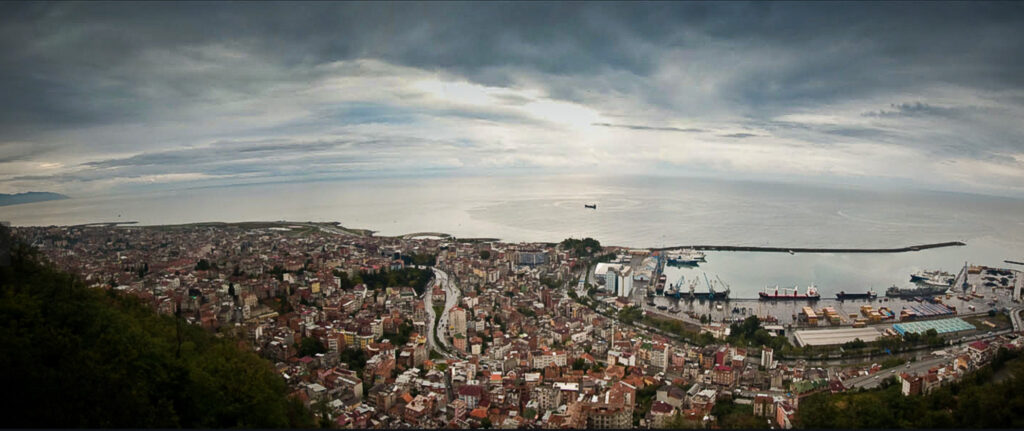
Aya Sofya (Hagia Sophia) of Trabzon
History and Architecture:
The Aya Sofya of Trabzon is a former Byzantine church built in the 13th century, shortly after the establishment of the Empire of Trebizond. It was constructed between 1238 and 1263 during the reign of Emperor Manuel I Komnenos, one of the most powerful rulers of the Empire of Trebizond. The church was modeled after the Hagia Sophia in Constantinople and was used as a key religious and cultural site during the Byzantine era.
Architecture:
• Design: Aya Sofya follows a cruciform plan typical of Byzantine architecture, with a central dome supported by four pillars and three apses. Its main feature is the high dome in the center, surrounded by smaller rooms and side aisles.
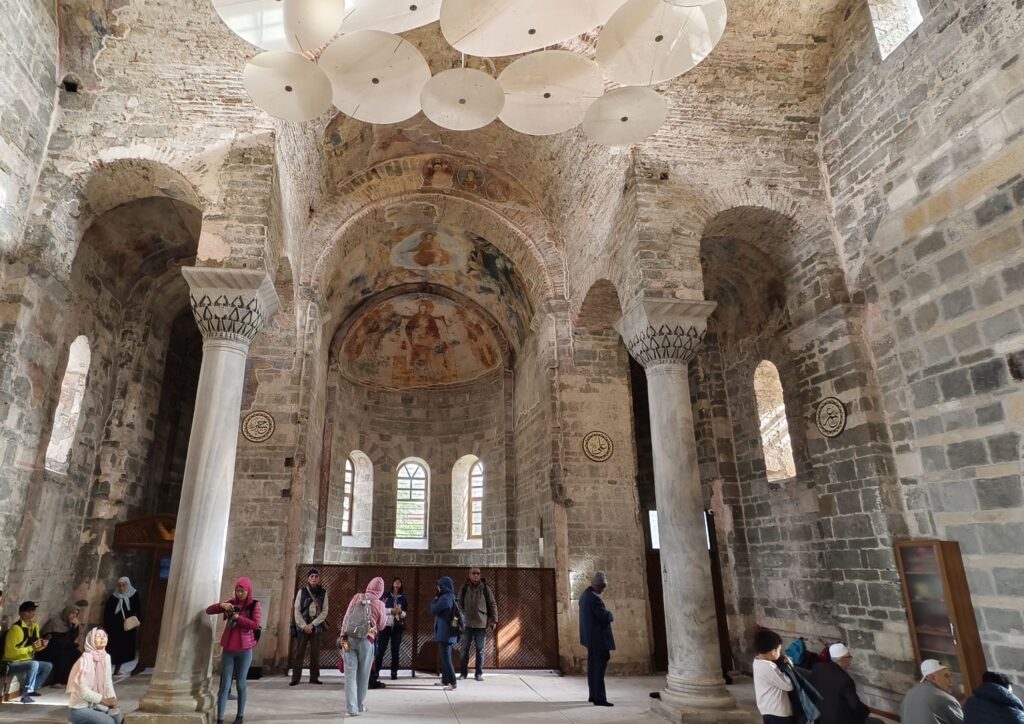
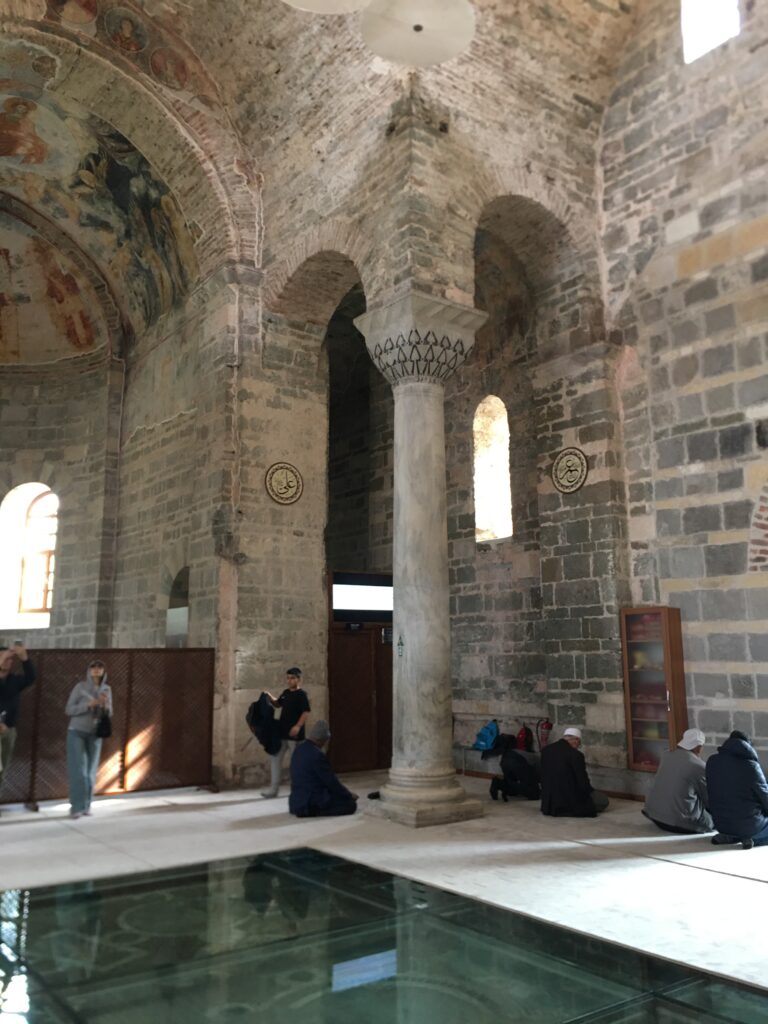
• Frescoes: Inside the church are stunning Byzantine frescoes that depict various scenes from the Bible, including the Last Judgment, the creation of Adam, and Christ Pantocrator. These frescoes were created by highly skilled local and Byzantine artisans and are considered some of the best examples of Byzantine art in the Black Sea region. The frescoes reflect the Eastern Orthodox Christian iconographic tradition.
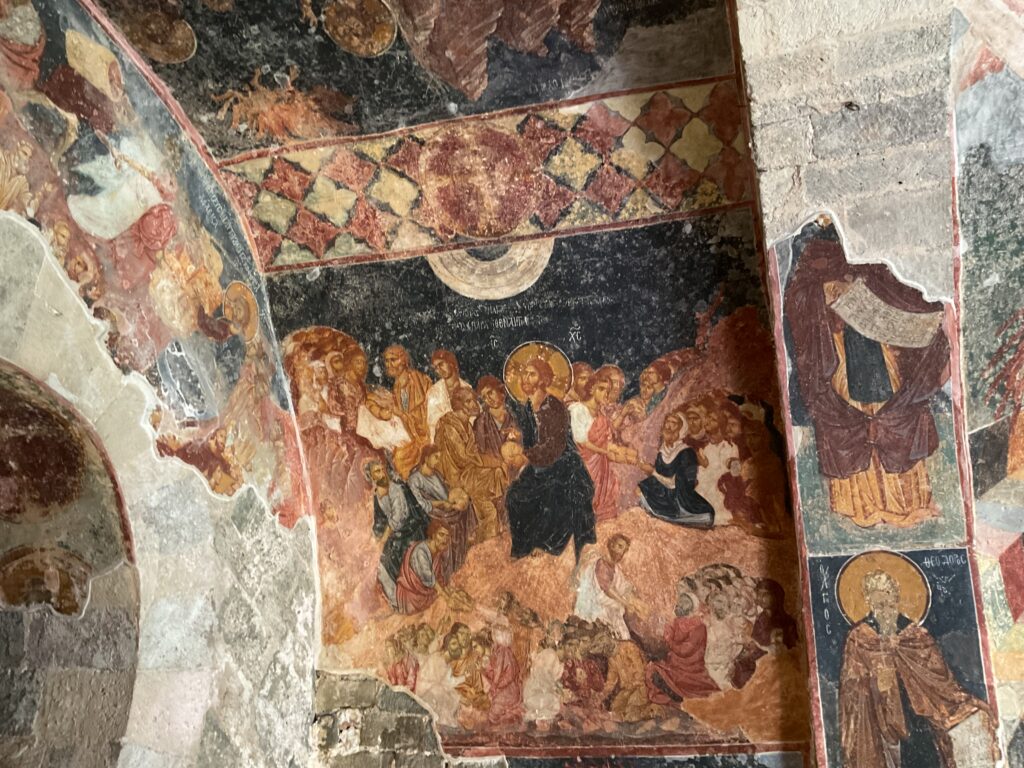
• Exterior: The exterior features a mixture of local stone and brick, with a portico supported by large stone columns. There are also remnants of classical and Hellenistic elements, as was common in Byzantine architecture.
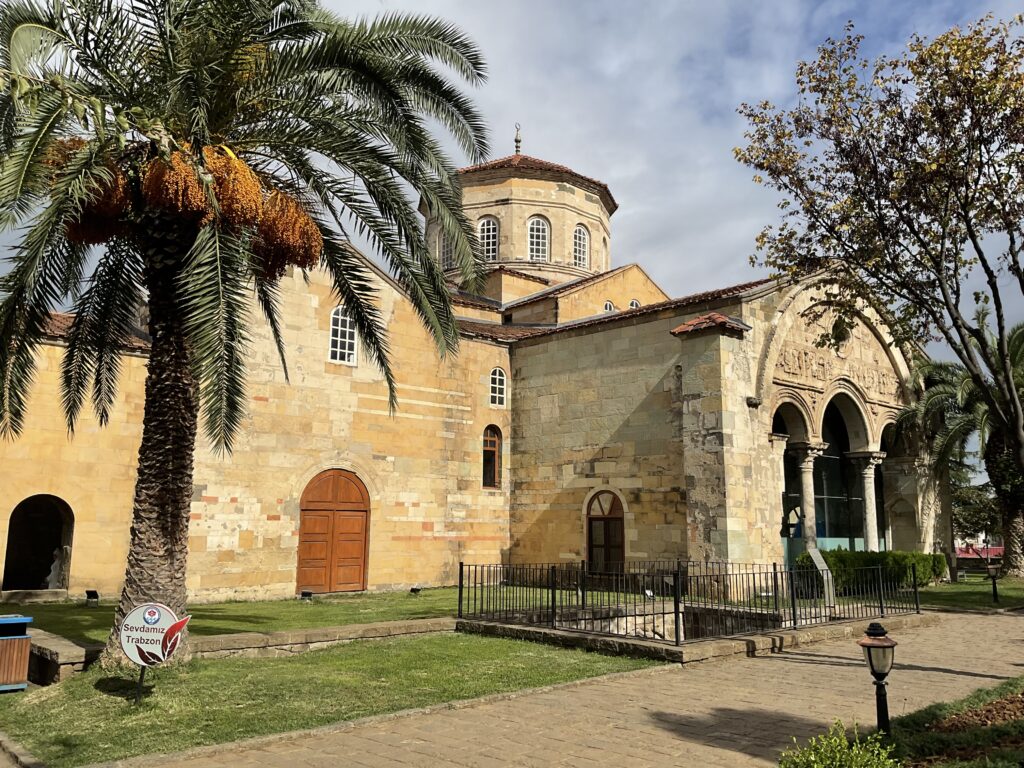
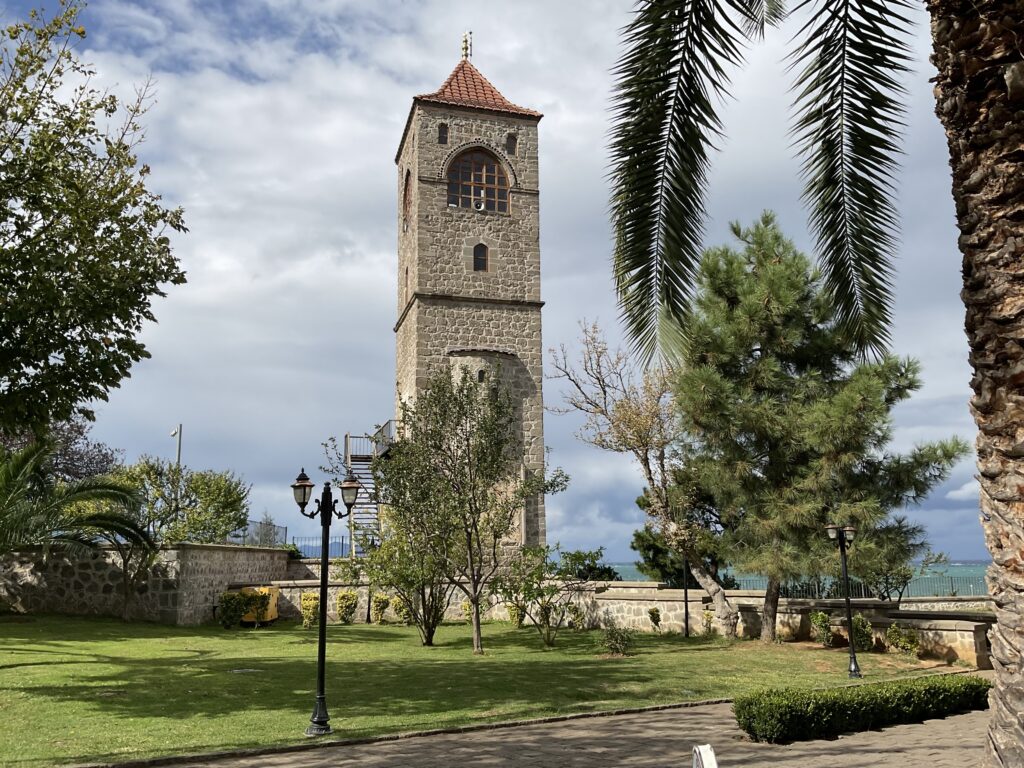
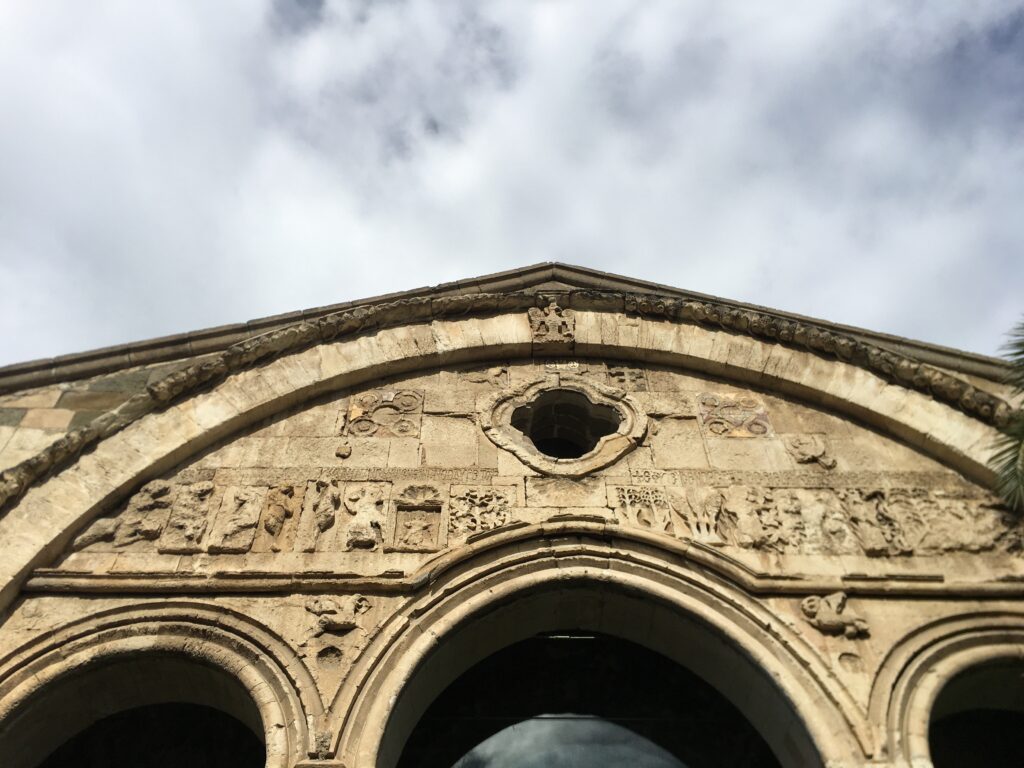
Later Use and Ottoman Era:
After the Ottoman conquest of Trabzon in 1461, the church was converted into a mosque in 1584. The Ottomans preserved much of the church’s structure but added Islamic elements, including a mihrab (prayer niche) pointing toward Mecca. Despite this conversion, many of the frescoes were whitewashed, a common practice when churches were transformed into mosques.
In the 20th century, following the establishment of the Turkish Republic, Aya Sofya was secularized and turned into a museum in 1964, allowing for the rediscovery and restoration of its frescoes. However, in 2013, it was reconverted into a mosque, sparking controversy due to the historical significance of the site and its importance as a Byzantine cultural monument.
Today, visitors can still see the beautiful frescoes and the unique combination of Byzantine and Ottoman architecture. It remains a symbol of Trabzon’s multi-layered history.
Sumela Monastery
History:
The Sumela Monastery is an Orthodox Christian monastery dedicated to the Virgin Mary. It is located on the steep cliffs of Mount Mela in the Pontic Mountains, about 48 km south of Trabzon. The history of the monastery is believed to date back to 386 AD, during the reign of Roman Emperor Theodosius I. According to legend, two Athenian monks, Barnabas and Sophronius, founded the monastery after discovering an icon of the Virgin Mary (believed to have been painted by St. Luke) in a cave on the mountain.
The monastery quickly became a major pilgrimage site for Christians, and over the centuries, it underwent numerous renovations and expansions, especially during the Byzantine era. It continued to thrive after the Ottoman conquest of the region in 1461, largely due to the Ottomans’ tolerance of Christian religious institutions.
Ottoman Period and Decline:
Despite being located in Ottoman territory, Sumela Monastery retained its status as a religious and cultural center for the Orthodox Christian community throughout the Ottoman period. The monastery continued to attract pilgrims and was a center of Orthodox learning, housing a significant library of religious texts.
However, in the early 20th century, Sumela Monastery experienced decline due to the political instability and population exchanges between Greece and Turkey. Following the 1923 population exchange that resulted in the departure of the Greek Orthodox population from the region, the monastery was abandoned.
Modern Restoration:
In the years following its abandonment, the monastery suffered from neglect and looting. However, it has been the subject of restoration efforts by the Turkish government, starting in the 1980s. Sumela Monastery was opened to the public as a museum and historical site, attracting thousands of visitors each year due to its stunning location and historical significance.
In recent years, the monastery has occasionally been used for religious services, particularly for the annual celebration of the Virgin Mary’s feast day on August 15th.
Sumela Monastery is not only a significant religious and historical site but also a marvel of engineering, perched dramatically on a cliffside and offering breathtaking views of the surrounding forests and valleys.
Sumela Monastery has several special features that distinguish it as a unique site both architecturally and historically:
1. Cliff-Side Location
One of Sumela Monastery’s most striking features is its location on a sheer cliff face of Mount Mela, 1,200 meters (3,900 feet) above sea level in the Pontic Mountains. The dramatic setting adds to its mystique, as the monastery seems to cling precariously to the rock, with breathtaking views over the surrounding forests and valleys. This remote and challenging location was chosen for its isolation, which was ideal for a monastic life dedicated to prayer and contemplation.
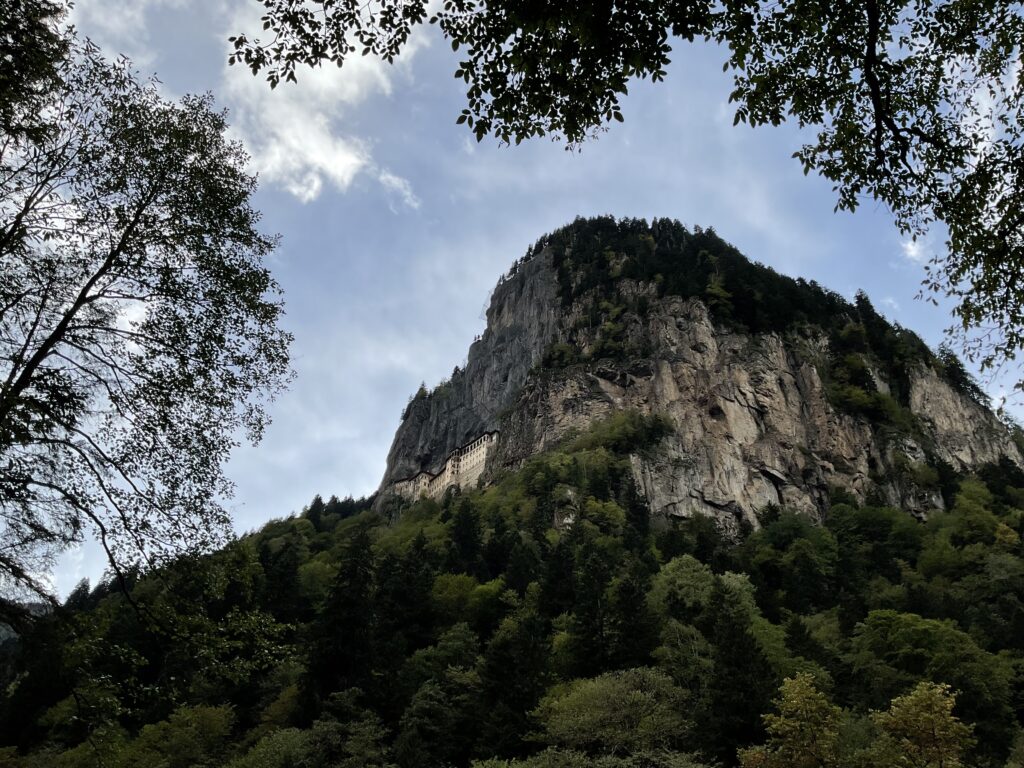
2. Rock-Hewn Church and Caves
At the heart of the monastery is the main church, which is carved directly into the rock. This church, dedicated to the Virgin Mary, is partly a natural cave, enhanced with Byzantine architectural features. The rock-hewn nature of the church and its integration with the cliff creates a harmonious balance between man-made structures and the natural landscape.
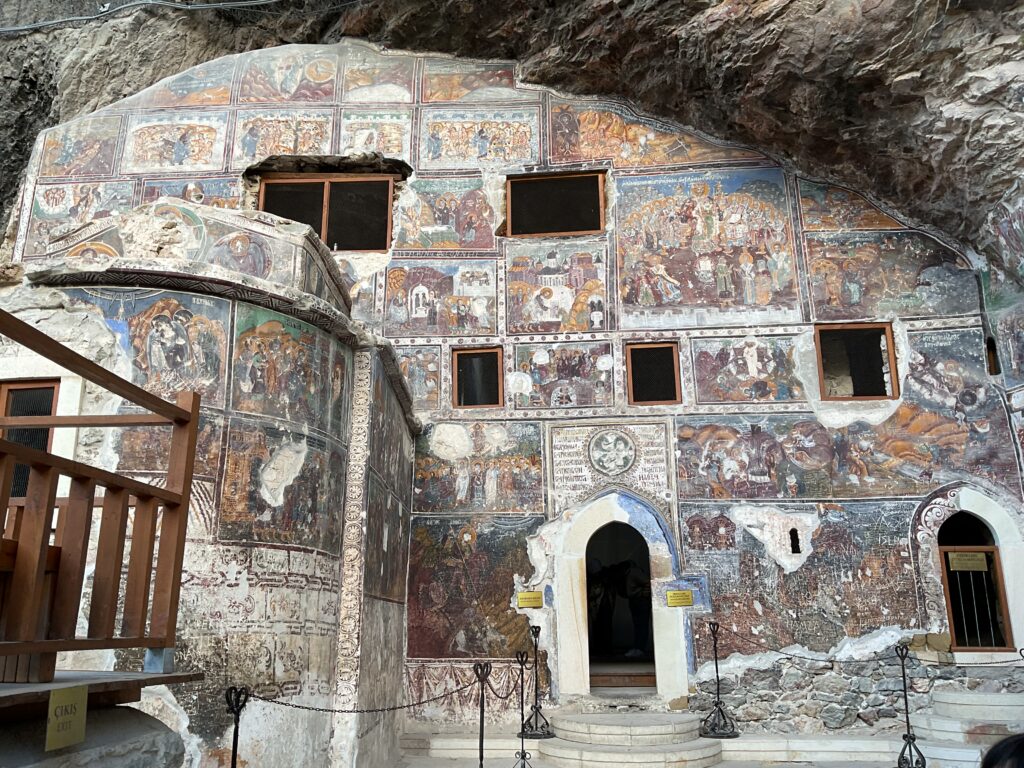
3. Frescoes
The interior of the main church is adorned with spectacular frescoes, which are among the most important artistic features of the monastery. These frescoes, dating from the 14th to the 18th centuries, depict:
• Biblical scenes, including the life of Christ and the Virgin Mary.
• Events from the Old Testament.
• Images of saints and angels in traditional Byzantine iconography.
The frescoes are painted directly onto the rock walls and ceiling, adding to the uniqueness of the church’s setting. Despite years of neglect, many of these frescoes remain vibrant and provide an important window into Byzantine art and religious life.
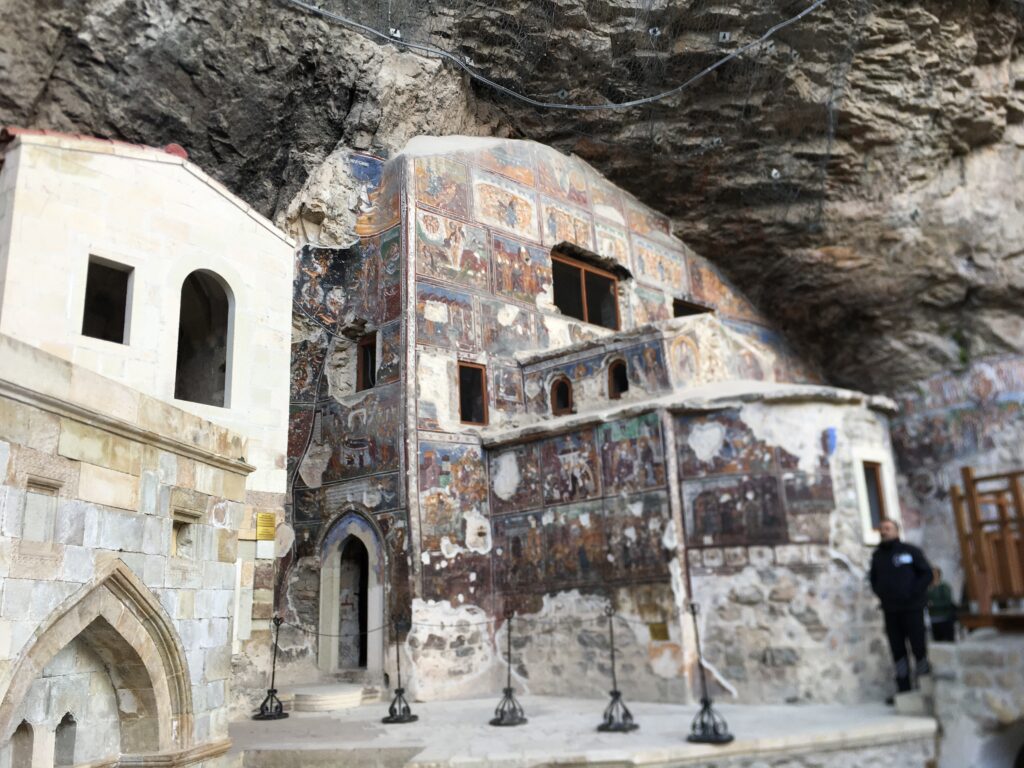
4. The Aqueduct
One of the monastery’s most impressive engineering feats is the aqueduct, which once brought fresh water to the monastery from the surrounding mountains. Although much of the aqueduct is now in ruins, its remnants show the skill required to build such a system in such a remote and inaccessible location. The aqueduct is visible along the cliff edge and adds to the dramatic visuals of the site.
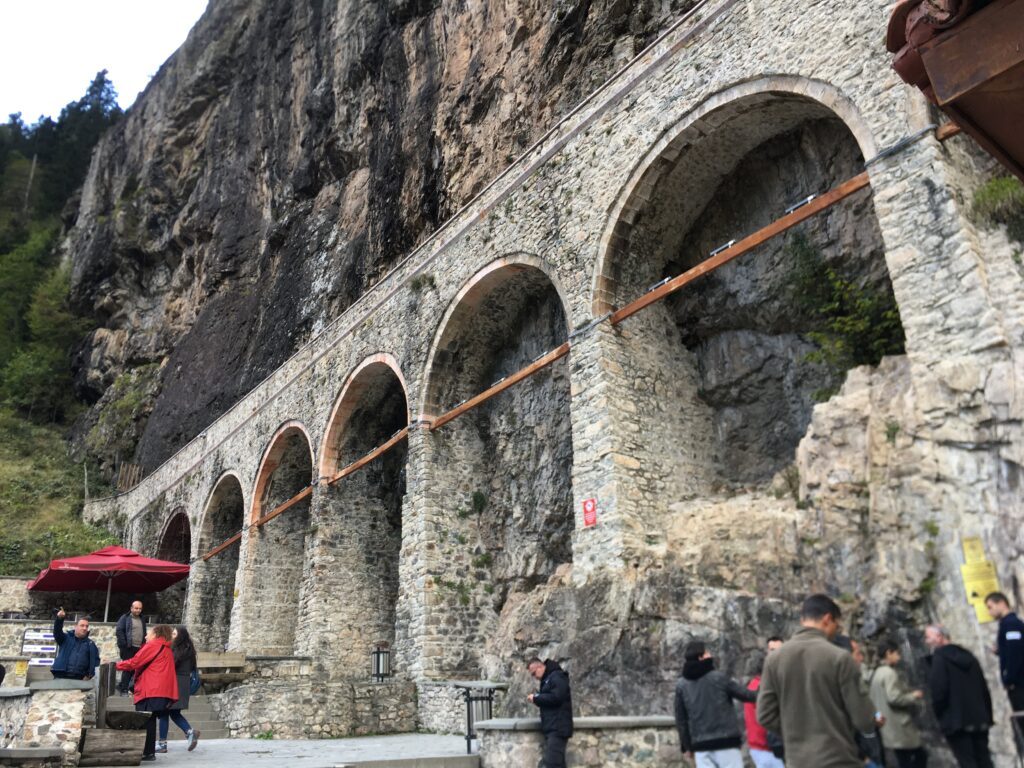
5. Monastic Cells and Structures
The Sumela complex consists of various interconnected rooms, chapels, and monastic cells, all built into the mountainside. These include:
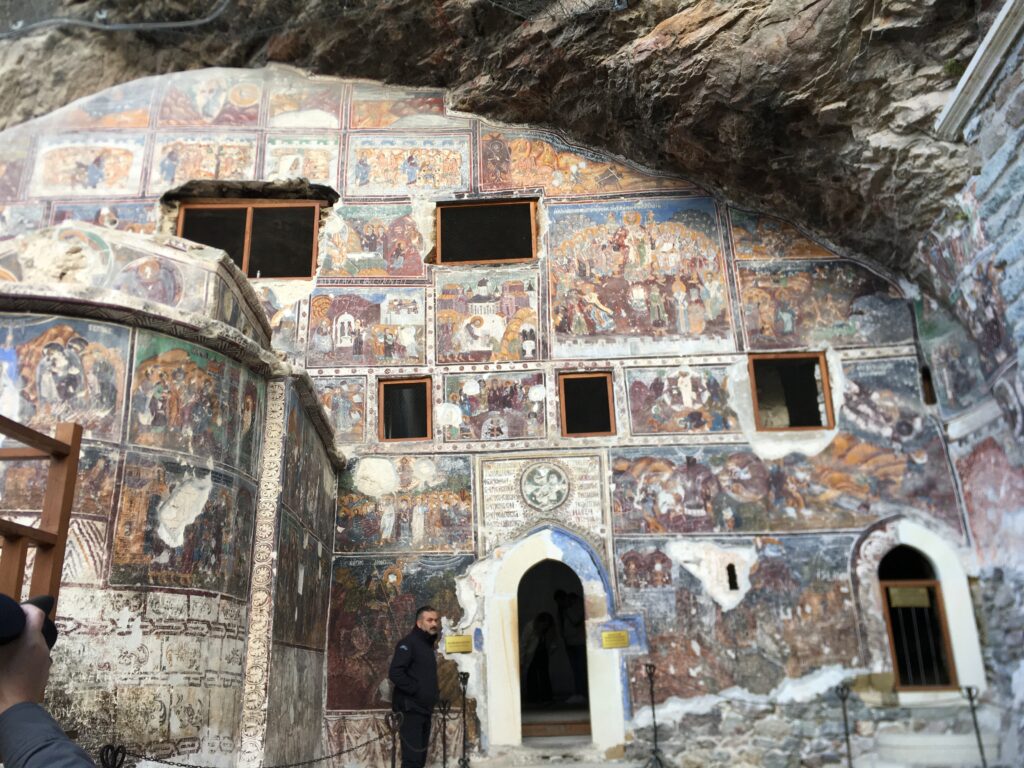
• Dormitories for the monks.
• Guesthouses for pilgrims and visitors.
• A library that once housed valuable religious texts and manuscripts.
• Kitchens and other utility rooms.
The monastery’s layout, with its narrow stairways and passageways connecting different parts of the complex, reflects the functional needs of a monastic community that sought seclusion from the outside world.
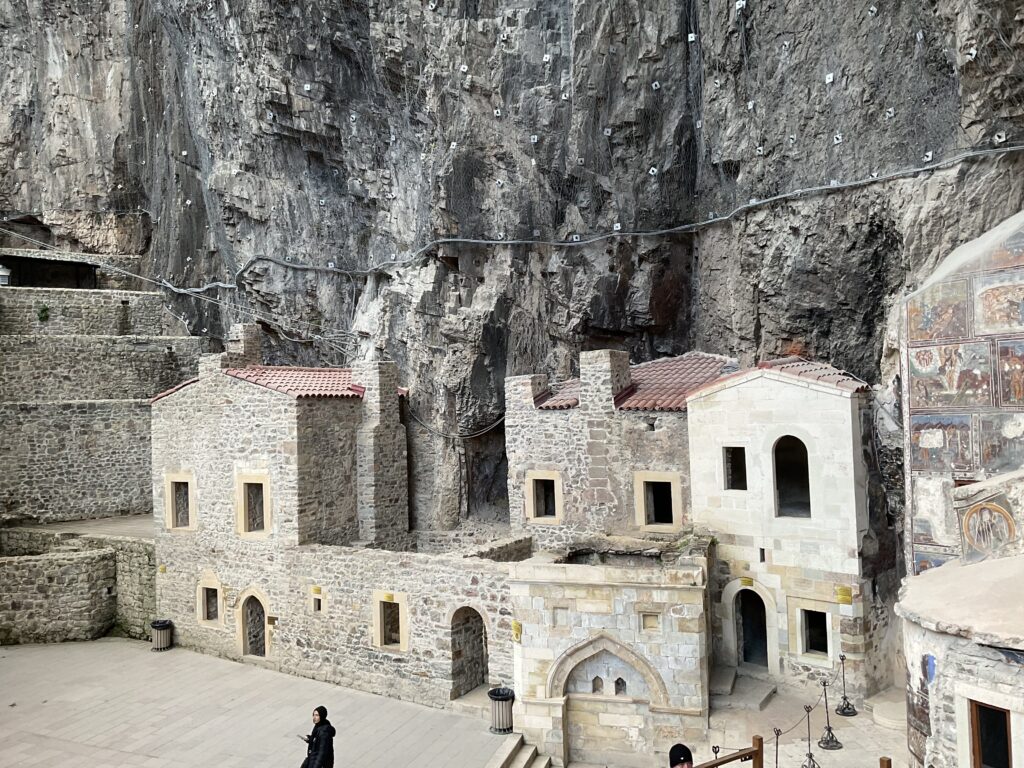
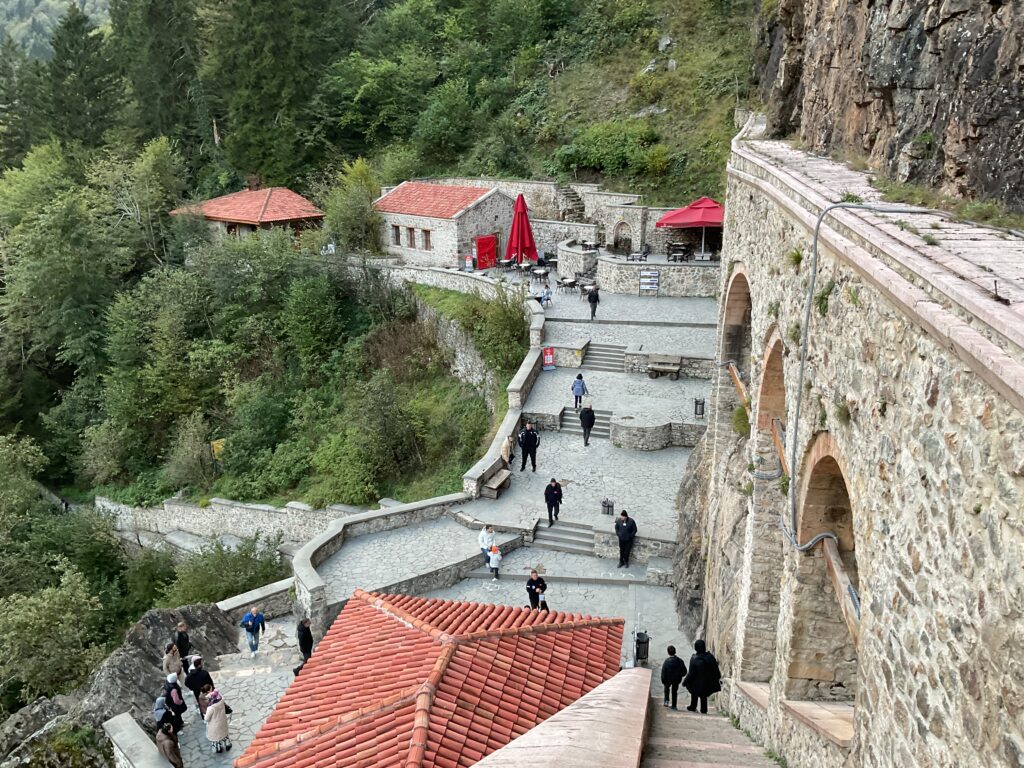
6. Virgin Mary Icon and Legend
According to legend, the monastery was founded after two Athenian monks, Barnabas and Sophronius, discovered an icon of the Virgin Mary in a cave on Mount Mela. This icon is said to have been painted by St. Luke, one of the authors of the Gospels, and became the central religious artifact of the monastery. While the original icon has since been lost, the legend surrounding it contributed to Sumela’s significance as a pilgrimage site.
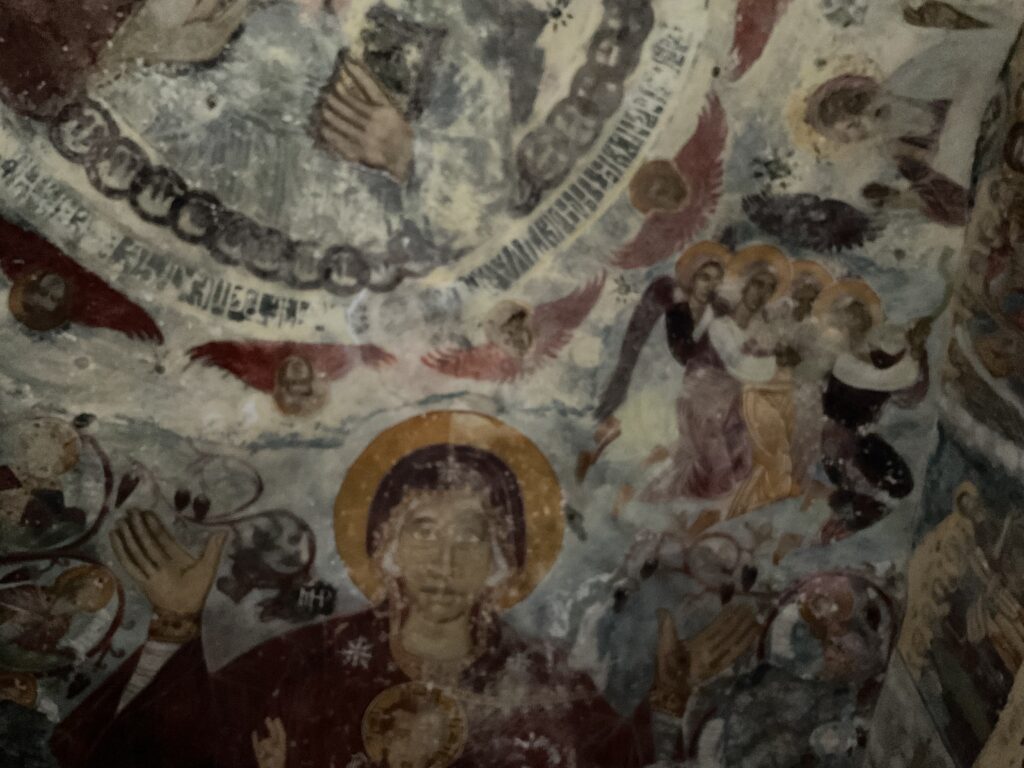
7. Unique Access
To reach the monastery, visitors today must take a steep, winding path through dense forests, which enhances the sense of isolation and spirituality. Historically, this inaccessibility contributed to the monastery’s security and longevity, protecting it from potential invaders or disruptions.
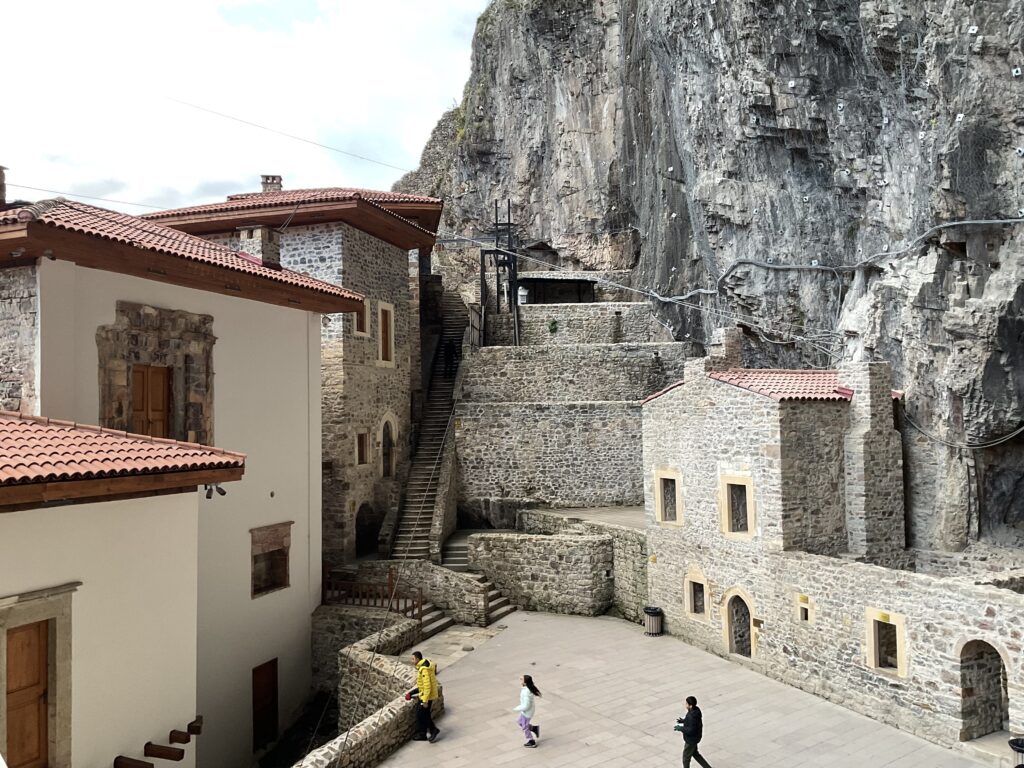
8. Annual Pilgrimage and Religious Services
Although abandoned after the population exchange in 1923, Sumela Monastery remains a site of spiritual importance for Orthodox Christians, especially Greeks. In recent years, it has been the location of an annual pilgrimage and liturgy, celebrated on August 15, the feast day of the Dormition of the Virgin Mary (Assumption). This special event draws thousands of pilgrims from around the world, who gather at the ancient site for prayer and worship.
9. Spiritual Ambiance
The overall spiritual ambiance of Sumela Monastery is one of solitude and mysticism, heightened by the natural beauty and remoteness of its surroundings. The sounds of waterfalls from nearby streams, the lush forest backdrop, and the secluded nature of the monastery all contribute to the contemplative atmosphere that monks and pilgrims historically sought out.
These unique features of Sumela Monastery make it one of the most iconic and revered religious sites in Turkey, reflecting the complex history of Byzantine and Orthodox monasticism in the region.
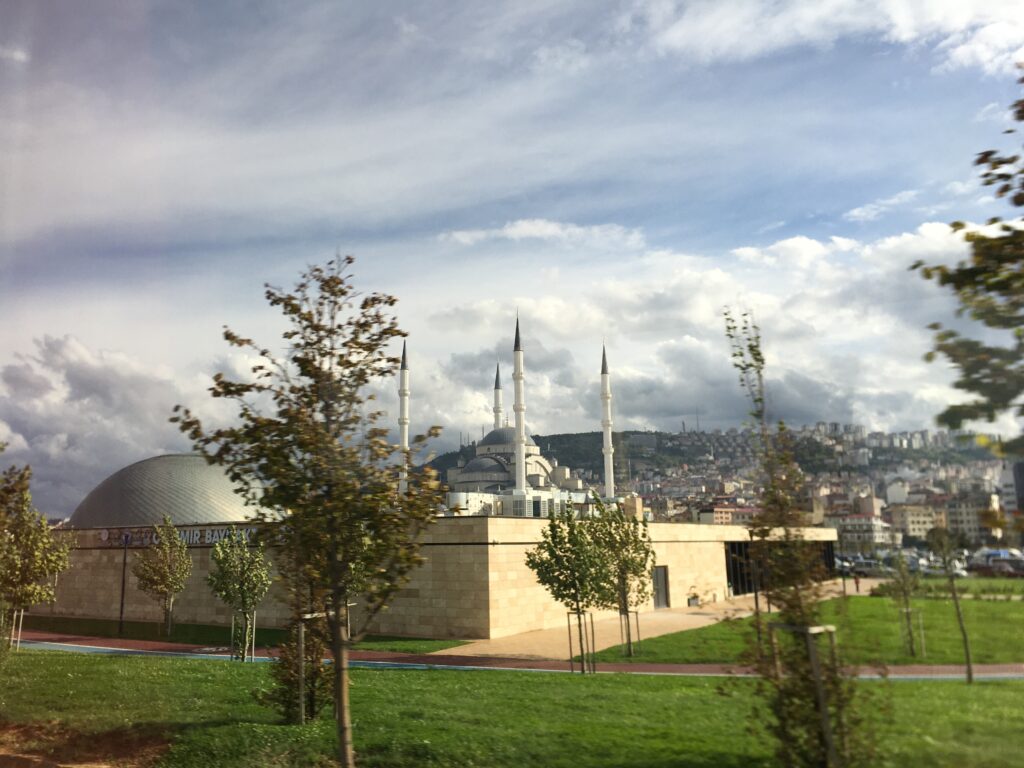
Here’s a well-balanced one-day itinerary for visiting Trabzon and Sumela Monastery, incorporating historical exploration and local food specialties:
Morning: Sumela Monastery
• 8:00 AM: Start early to head towards Sumela Monastery, about a 45-minute drive from Trabzon.
• Tip: Hire a car or take a guided tour for easier access.
• 9:00 AM: Arrive at Sumela Monastery.
• Explore the ancient rock-hewn monastery, the frescoes, and enjoy the breathtaking views of the Altindere Valley. Allow about 2–3 hours to explore the monastery thoroughly and take in the natural surroundings.
• Don’t miss: The frescoes inside the monastery and the panoramic view from the cliffside.
• 11:30 AM: Start your return to Trabzon.
Lunch: Taste Local Specialties
• 1:00 PM: Back in Trabzon, head to a local restaurant for lunch.
• Recommended dish: Try Akçaabat Köftesi, a famous meatball dish from the nearby town of Akçaabat, made with minced meat and spices, usually served with fresh vegetables, pita bread, and ayran (yogurt drink).
• Where to eat: Head to a traditional restaurant in Akçaabat or central Trabzon, like Cemilusta or Nihat Usta, which are known for serving the best Akçaabat Köfte.
Afternoon: Explore Trabzon
• 2:30 PM: Visit the Aya Sofya of Trabzon.
• This 13th-century church-turned-mosque offers rich history, stunning frescoes, and impressive architecture. Spend about an hour here, appreciating the fusion of Byzantine and Ottoman influences.
• 3:45 PM: Visit the Atatürk Mansion.
• Located on a hill with beautiful gardens, this early 20th-century mansion was a summer residence for Atatürk, the founder of modern Turkey. It’s also a peaceful spot to learn more about Turkish history while enjoying the picturesque views over the city.
Afternoon Café Break
• 5:00 PM: Enjoy a traditional Trabzon-style tea at a local tea house or café with a view of the Black Sea. Pair your tea with a local pastry like Laz Böreği, a delicious layered pastry filled with sweet semolina cream, or Hamsiköy Sütlacı, a traditional rice pudding from the nearby Hamsiköy village.
Evening: Explore Trabzon’s Bazaar
• 6:00 PM: Head to Trabzon Bazaar, located in the city center, to explore local shops and crafts. The bazaar offers everything from hand-woven carpets to jewelry and local delicacies like Trabzon butter and honey.
• Stroll around, shop for souvenirs, and soak in the local atmosphere.
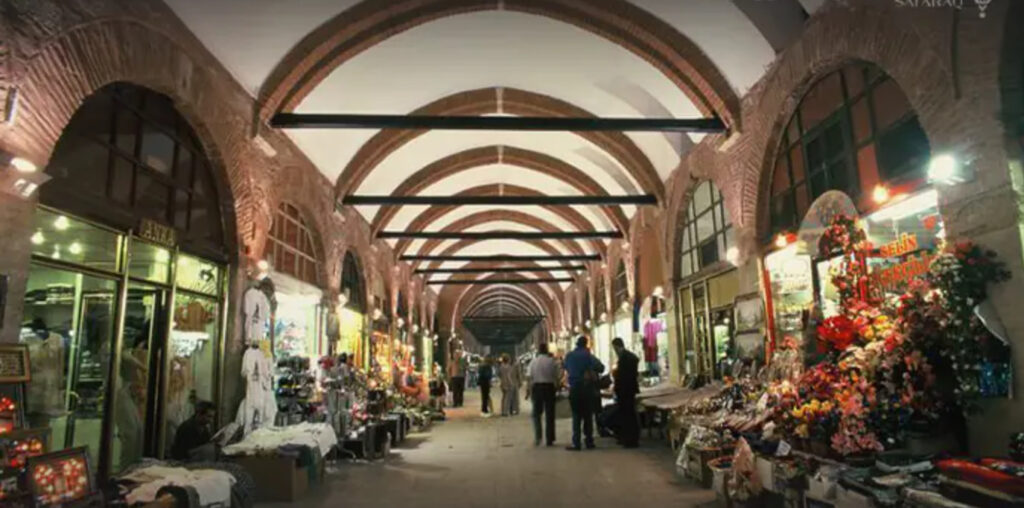
Dinner: Indulge in Black Sea Cuisine
• 7:30 PM: End your day with a dinner that showcases the Black Sea region’s seafood and specialties.
• Recommended dish: Try Hamsi Tava, fried anchovies, which are the pride of Trabzon’s cuisine, served with salad and cornbread. Alternatively, enjoy Kuymak (also known as Mihlama), a traditional Black Sea dish made of cornmeal, butter, and melted cheese, often eaten with fresh bread.
• Where to eat: Consider Cemil Usta or Balıkçı İhtiyar, known for their authentic Black Sea dishes.
9:00 PM: After dinner, take a short walk along the Trabzon coastline, enjoying the cool evening breeze from the Black Sea before calling it a day.
This itinerary combines the spiritual and historical exploration of Trabzon and Sumela Monastery with an indulgence in local cuisine, providing a well-rounded experience of the region.
